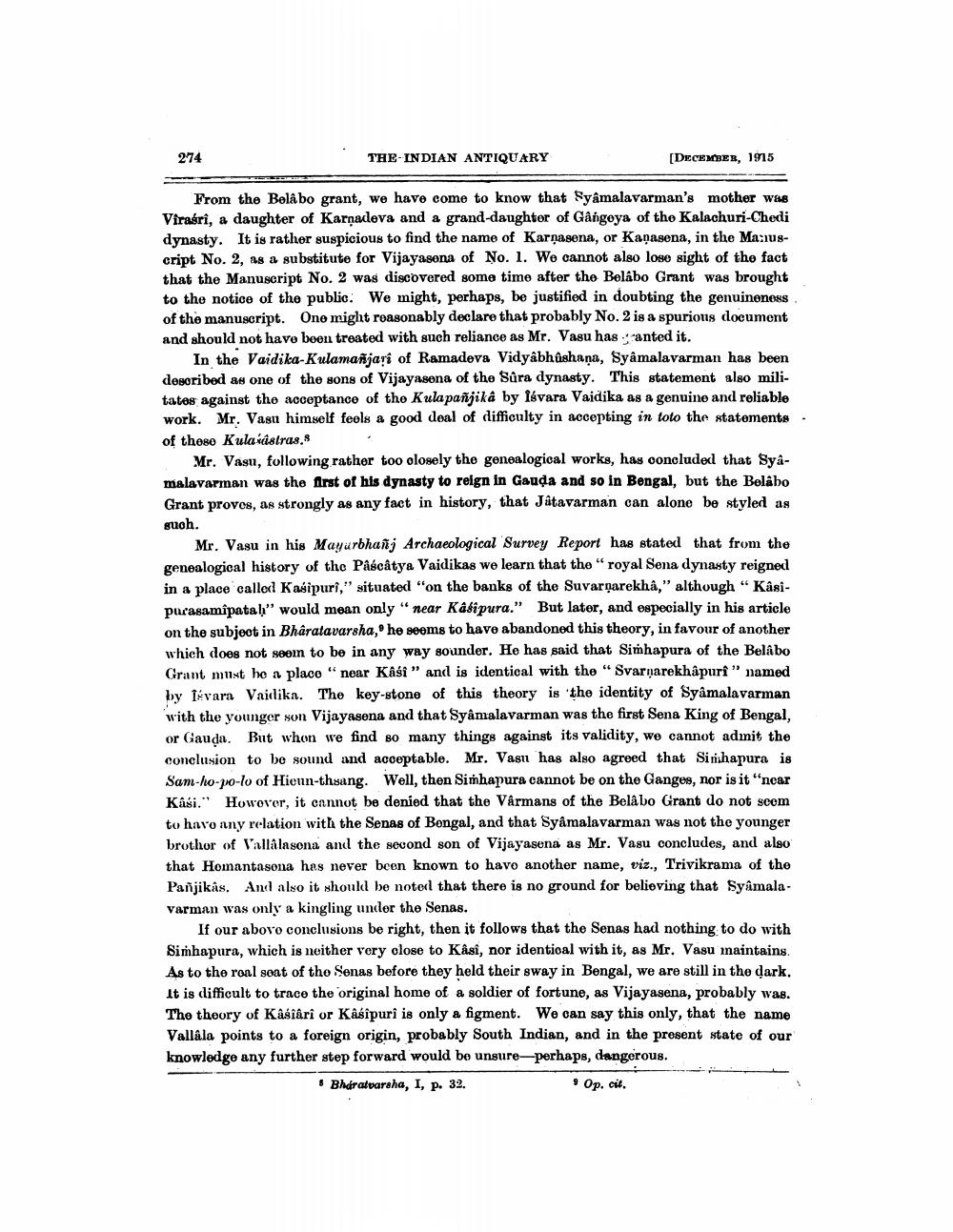________________
274
THE INDIAN ANTIQUARY
[DECEMBER, 1915
From the Belkbo grant, we have come to know that Syamalavarman's mother was Virasri, a daughter of Karnadeva and a grand-daughter of Gângoya of the Kalachuri-Chedi dynasty. It is rather suspicious to find the name of Karnasena, or Kanasena, in the Ma 108cript No.2, as a substitute for Vijayasena of No. 1. We cannot also lose sight of the fact that the Manuscript No. 2 was discovered some time after the Belábo Grant was brought to the notice of the public. We might, perhaps, be justified in doubting the genuineness of the manuscript. One might reasonably declare that probably No. 2 is a spurious document and should not have been treated with such reliance as Mr. Vasu hasranted it.
In the Vaidika-Kulamasjari of Ramadeva Vidyâbhâshaņa, Syâmalavarman has been described as one of the sons of Vijayasena of the Sûra dynasty. This statement also militates against the nocoptance of the Kulapañjika by Isvara Vaidika as a genuine and reliable work. Mr. Vasu himself fools a good deal of difficulty in accepting in toto the statements . of these Kulakáslras.
Mr. Vasu, following rather too closely the genealogical works, has concluded that Syamalavarman was the first of his dynasty to reign in Gauda and so in Bengal, but the Belabo Grant proves, as strongly as any fact in history, that Jatavarman can alone be styled as suoh.
Mr. Vasu in his Mayurbhanj Archaeological Survey Report has stated that from the genealogical history of the Pascâtya Vaidikas we learn that the royal Sona dynasty reigned in a place callo Kasipuri," situated "on the banks of the Suvargarekha," although “Käsipucasamipatal" would mean only " near Kasi pura." But later, and especially in his article on the subjoot in Bhâratavarsha, he seems to have abandoned this theory, in favour of another which does not seem to be in any way sounder. He has said that Simhapura of the Belabo Grant must be a placo "near Kasi" and is identical with the "Svarnarekhâpuri " named by Távara Vaidika. The key-stone of this theory is the identity of Syâmalavarman with the younger son Vijayasena and that Syamalavarman was the first Sena King of Bengal. or Gauda. But whon we find so many things against its validity, we cannot admit the conclusion to be sound and acceptable. Mr. Vasu has also agreed that Sirihapura is Sam-ho-pro-lo of Hienn-thsang. Well, then Simhapura cannot be on the Ganges, nor is it "near Kasi." Howover, it ennnot be denied that the Vårmans of the Belâbo Grant do not seem to havo any relation with the Senas of Bengal, and that Syâmalavarman was not the younger brothor of Vallalasona and the second son of Vijayasena as Mr. Vasu concludes, and also that Homantasona has never been known to have another name, viz., Trivikrama of the Panjikas. And also it should be noted that there is no ground for believing that Syamalavarman was only a kingling under the Senas.
If our abovo conclusions be right, then it follows that the Senas had nothing to do with Simhapura, which is neither very olose to Kâsî, nor identioal with it, as Mr. Vasu maintains As to the roal soat of tho Senas before they held their sway in Bengal, we are still in the dark. It is difficult to trace the original home of a soldier of fortune, as Vijayasena, probably was. The theory of Kasiari or Kasipuri is only a figment. We can say this only, that the name Vallála points to a foreign origin, probably South Indian, and in the present state of our knowledge any further step forward would be unsure-perhaps, dangerous. • Bhdratvaraha, I, p. 32.
• Op. cit.




